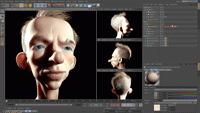Cinema 4D Studio brings dazzle to mobile TV production

Part of a well-designed mobile app has to do with an easy and visually engaging interface. Interactive mobile TV apps can make it on features, but usability often drives mass acceptance. Maxon has just released a new version of its Cinema 4D software program for creating these types of interface and app designs.
Apple’s iOS 5 iAd Network has been focused on the user experience and leans heavily toward the use of 3-D graphics; mobile video; and sharp, colorful graphics. The goal is to not create a disruptive ad that annoys, but a truly interactive brand engagement that delights and entertains. This could indeed be the future of advertising, as consumers don’t often have the patience for flat banner advertising.
As the movement toward more interactive and friendly advertising grows with smartphones, programs such as Cinema 4D Studio become increasingly important. Whereas developers could previously get away with creating in Adobe Photoshop, now programs such as Cinema 4D, with 3-D design and animation, are becoming the norm.
Cinema 4D Studio Release 13 is a complete software suite that offers 3-D rendering and animation. It exports to many formats, including Flash for deployment on devices such as Android, as well as a large variety of file types compatible with smartphones and iOS devices.
The newest R13 version has many new features designed to make 3-D look more realistic, and more like actual video or film. It’s often easier to get away with that on the smaller screens of portable devices. The new version of Cinema 4D sports a new physically correct depth-of-field feature, so renderings can have a lot of spatial depth and look more photo-realistic. 3-D motion blur has been improved and is based on real optical parameters.
Both the depth of field and motion blur are actually rendered as part of the scene, and not as a post-production effect. A lot of 3-D software will “cheat” and apply effects after a render. Although some effects done this way may look fine, they won’t approach the realism of effects that are rendered as part of the actual scene.
Also new are improved camera controls, which allow users to actually adjust a virtual camera for their scenes and tweak focal length, shutter speed, gain, ISO and f-stop. Users can now easily simulate exposure, lens distortion, chromatic aberration, vignetting and other camera attributes to make output as realistic as possible.
The professional video industry's #1 source for news, trends and product and tech information. Sign up below.
3-D stereoscopic smartphones and devices will be the next big thing in the coming year or two. The industry is already seeing phones with 3-D capabilities, and YouTube and online video portals are already amassing a large collection of 3-D clips. Cinema 4D Studio R13 is ready with new modes for stereo rendering for 3-D devices. Any Cinema 4D scene can easily be switched to stereoscopic output, with controls for eye separation and convergence, safe regions and depth. The software itself now supports simultaneous 3-D viewing and production. It also provides advanced support for Anaglyph, Side-by-Side, Interlaced or Active Shutter modes for compatibility with a large array of 3-D monitors, projectors and glasses. A complete rundown of all the new features are listed on the Maxon website.
So how is the program to use? Although there is a learning curve, the software and documentation, built-in tutorials, as well as the company’s optional advanced video tutorial website, Cineversity, offer hours and hours of help. The interface is continually streamlined, and the software appeals to a wide range of users. Beginners can get up and rolling doing basic 3-D, while the software offers advanced users more power and flexibility.
Maxon also has various versions of Cinema 4D that target different markets (including Cinema 4D Broadcast, Visualize and Prime) in case the full Studio version is overkill.
